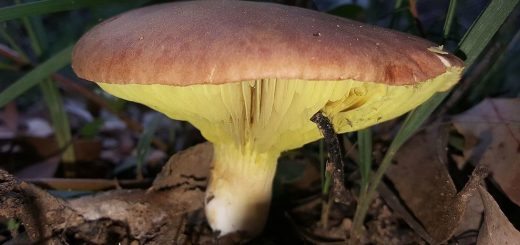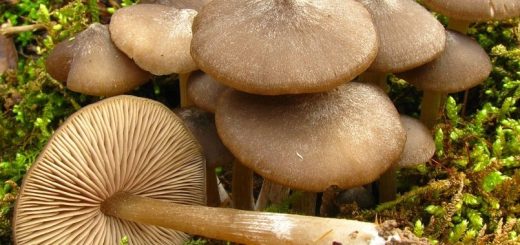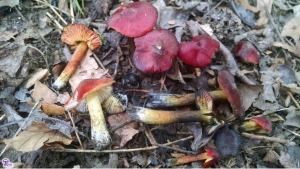#072: Leucocooprinus birnbaumii, The Yellow Houseplant Mushroom
This small, yellow, parasol mushroom is a tropical species but can be found throughout the world in greenhouses and indoors among potted plants. These mushrooms often surprise people by appearing suddenly indoors at any time of the year. birnbaumii is a mostly harmless mushroom. It does not damage your plants at all, but it should not be eaten. The Yellow Houseplant Mushroom is mildly poisonous, but symptoms appear only when it is eaten in large quantities. If you are worried that a pet or child may eat the mushrooms, then you may want to pick the mushrooms and throw them out. This will not get rid of the fungus, so you will have to check the pot regularly. The mushrooms may also spread to other pots in your house through airborne spores. If you want to get rid of them forever, then you will probably have to throw away your houseplant. For those of you not concerned about accidental ingestion, feel free to enjoy the extra splash of color that the Yellow Houseplant Mushroom brings to your room!*
The young fruiting bodies of L. birnbaumii start out as little more than tiny, yellow ovals protruding from the soil. As the mushroom grows, the stalk elongates and gets bigger. The cap also grows in size, but remains oval-shaped. At this intermediate stage, the mushroom looks kind of like a small, yellow, fuzzy microphone. This microphone shape is frequently somewhat distorted because the base is usually expanded and there is often an extra bump at the top of the oval pileus. The entire mushroom is colored yellow and covered with tiny, yellow scales. As the mushroom matures, the bottom of the cap separates from the stipe and expands like an umbrella being opened. A small, fragile ring is left on the stipe where the edge of the cap was, but this frequently disappears soon after the cap begins expainding. The fully-grown pileus will be broadly conical to bell-shaped. At this stage, the pileus begins to lose some of its color. The edge of the cap becomes yellowish white to pale yellow and the rest of the cap darkens toward the center. No scales are added to the pileus once it starts expanding, so the yellow scales become spread out (except for those over the center), diluting the color further. Underneath the pileus, the mushroom sports pale yellow gills that are free from the stipe. The gills give a white spore print. Even fully grown, these mushrooms are not very big. They are 3-10cm (1.2-4in) tall and 2.5-6cm (1-2.4in) wide. Despite this, these brightly-colored mushrooms are almost impossible to miss when they are growing indoors.
L. birnbaumii is saprobic and feeds on dead plant material. This means that it does not harm your potted plants. Actually, it helps release nutrients back into the soil, which is beneficial to your plants. In temperate regions, the Yellow Houseplant Mushroom is usually spread through infected soil. If you find these mushrooms growing in your house, they either came from the greenhouse that grew your plant or came with the soil you added to your potted plant. Although greenhouses and soil companies try to exclude mushrooms like L. birnbaumii from their products, there are occasionally some intrepid individuals sneak through. People can carry the spores from one greenhouse to another, making eradication of this mushroom a difficult problem to tackle. The Yellow Houseplant Mushroom is most commonly encountered indoors, but it can occasionally be found outdoors. In temperate North America, it prefers to fruit in the summer from cultivated areas like gardens. It can sometimes be found growing in forests, usually near disturbed ground.
L. birnbaumii belongs to the phylum Basidiomycota, class Agaricomycetes, order Agaricales, and family Agaricaceae. A more familiar member of this taxonomic family is Agaricus bisporus, which can be found in a number of varieties at your local grocery store (see FFF#002 for more on A. bisporus). The species name birnbaumii pays tribute to a German garden inspector named Birnbaum who found the mushrooms growing alongside pineapples in a noble’s garden in 1839. There are many different common names for this fungus, but most are variations of “Yellow Houseplant Mushroom,” which is the name most often used in the United States. In the United Kingdom, however, the preferred common name is “the Plantpot Dapperling.”
* Note: growing lots of mushrooms indoors can result in breathing problems. A high concentration of airborne spores will cause symptoms similar to smoke inhalation. For this reason, you should not cultivate mushrooms indoors. That being said, a few mushrooms growing alongside a houseplant will probably not produce enough spores to cause any problems. People who experience symptoms usually either are growing large quantities of oyster mushrooms in their home or are working in the mushroom industry and not following proper safety procedures.
See Further:
http://www.mushroomexpert.com/leucocoprinus_birnbaumii.html
http://botit.botany.wisc.edu/toms_fungi/feb2002.html
http://www.mykoweb.com/CAF/species/Leucocoprinus_birnbaumii.html
http://www.first-nature.com/fungi/leucocoprinus-birnbaumii.php
http://www.kew.org/science-conservation/plants-fungi/leucocoprinus-birnbaumii-plantpot-dapperling









![#011: Characteristics of Kingdom Fungi [Archived]](https://www.fungusfactfriday.com/wp-content/themes/hueman/assets/front/img/thumb-small-empty.png)

